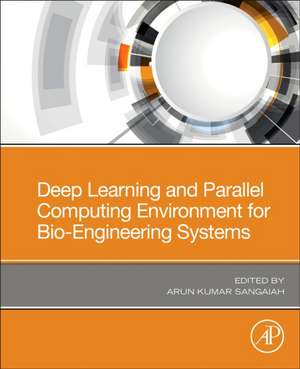Deep Learning and Parallel Computing Environment for Bioengineering Systems
Editat de Arun Kumar Sangaiahen Limba Engleză Paperback – 26 iul 2019
- Presents novel, in-depth research contributions from a methodological/application perspective in understanding the fusion of deep machine learning paradigms and their capabilities in solving a diverse range of problems
- Illustrates the state-of-the-art and recent developments in the new theories and applications of deep learning approaches applied to parallel computing environment in bioengineering systems
- Provides concepts and technologies that are successfully used in the implementation of today's intelligent data-centric critical systems and multi-media Cloud-Big data
Preț: 727.79 lei
Preț vechi: 1004.33 lei
-28% Nou
Puncte Express: 1092
Preț estimativ în valută:
139.28€ • 144.18$ • 117.72£
139.28€ • 144.18$ • 117.72£
Carte tipărită la comandă
Livrare economică 26 februarie-12 martie
Preluare comenzi: 021 569.72.76
Specificații
ISBN-13: 9780128167182
ISBN-10: 0128167181
Pagini: 280
Ilustrații: Approx. 250 illustrations
Dimensiuni: 191 x 235 x 14 mm
Greutate: 0.49 kg
Editura: ELSEVIER SCIENCE
ISBN-10: 0128167181
Pagini: 280
Ilustrații: Approx. 250 illustrations
Dimensiuni: 191 x 235 x 14 mm
Greutate: 0.49 kg
Editura: ELSEVIER SCIENCE
Public țintă
KEYWORDS: Deep Learning; Parallel Computing; Bio-Engineering; Data Analytics & Optimization; Recommendatiyn Systems; Artificial Intelligence and Expert System; Predictive Computational Models; Data-Centric Service Modelling; Big Data Infrastructure Designs; Adaptive Forecasting SystemsCuprins
1. Introductory
2. Theoretical results on representation of deep learning and parallel architectures for bioengineering
3. Parallel Machine Learning and Deep Learning approaches for Bio-informatics
4. Parallel programming, architectures and machine intelligence for bioengineering
5. Deep Randomized Neural Networks for Bioengineering applications
6. Artificial Intelligence enhance parallel computing environments
7. Parallel computing, graphics processing units (GPU) and new hardware for deep learning in Computational Intelligence research
8. Novel feature representation using deep learning, dictionary learning for face, fingerprint, ocular, and/or other biometric modalities
9. Novel distance metric learning algorithms for biometrics modalities
10. Machine learning techniques (e.g., Deep Learning) with cognitive knowledge acquisition frameworks for sustainable energy aware systems
11. Deep learning and semi-supervised and transfer learning algorithms for medical imaging
12. Biological plausibility/inspiration of Randomized Neural Networks
13. Genomic data visualisation and representation for medical information
14. Applications of deep learning and unsupervised feature learning for prediction of sustainable engineering tasks
15. Inference and optimization with bioengineering problems
2. Theoretical results on representation of deep learning and parallel architectures for bioengineering
3. Parallel Machine Learning and Deep Learning approaches for Bio-informatics
4. Parallel programming, architectures and machine intelligence for bioengineering
5. Deep Randomized Neural Networks for Bioengineering applications
6. Artificial Intelligence enhance parallel computing environments
7. Parallel computing, graphics processing units (GPU) and new hardware for deep learning in Computational Intelligence research
8. Novel feature representation using deep learning, dictionary learning for face, fingerprint, ocular, and/or other biometric modalities
9. Novel distance metric learning algorithms for biometrics modalities
10. Machine learning techniques (e.g., Deep Learning) with cognitive knowledge acquisition frameworks for sustainable energy aware systems
11. Deep learning and semi-supervised and transfer learning algorithms for medical imaging
12. Biological plausibility/inspiration of Randomized Neural Networks
13. Genomic data visualisation and representation for medical information
14. Applications of deep learning and unsupervised feature learning for prediction of sustainable engineering tasks
15. Inference and optimization with bioengineering problems




















